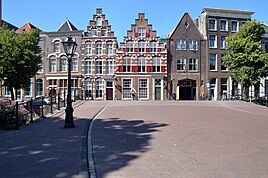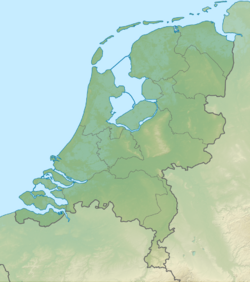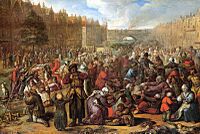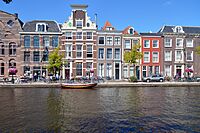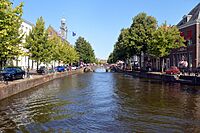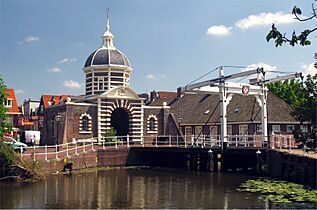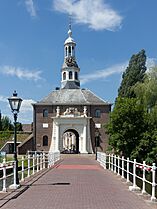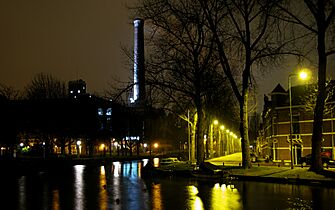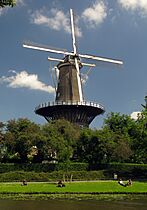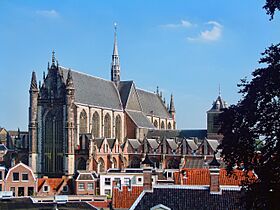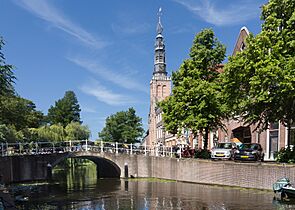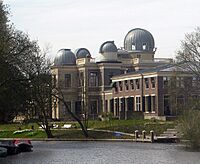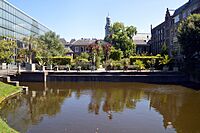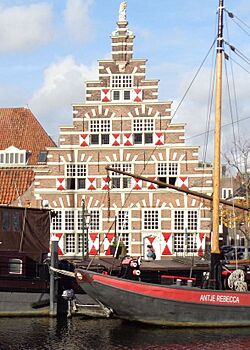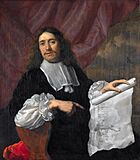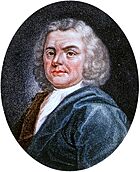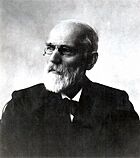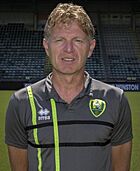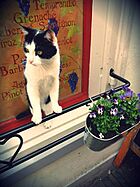Leiden facts for kids
Quick facts for kids
Leiden
|
|||
|---|---|---|---|
|
City and municipality
|
|||
|
Rapenburg
Koornbrug
Aalmarkt
Steenschuur
Tophograpic map
|
|||
|
|||
| Nickname(s):
Sleutelstad (Key City)
|
|||
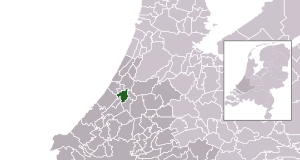
Location in South Holland
|
|||
| Country | |||
| Province | |||
| Government | |||
| • Body | Municipal council | ||
| Area | |||
| • Municipality | 23.27 km2 (8.98 sq mi) | ||
| • Land | 21.95 km2 (8.47 sq mi) | ||
| • Water | 1.32 km2 (0.51 sq mi) | ||
| Elevation | 0 m (0 ft) | ||
| Population
(Municipality, May 2014; Urban and Metro, May 2014)
|
|||
| • Municipality | 121,249 | ||
| • Density | 5,524/km2 (14,310/sq mi) | ||
| • Urban | 258,923 | ||
| • Metro | 344,299 | ||
| Demonym(s) | Leidenaar | ||
| Time zone | UTC+1 (CET) | ||
| • Summer (DST) | UTC+2 (CEST) | ||
| Postcodes |
2300–2334
|
||
| Area code | 071 | ||
| Click on the map for a fullscreen view | |||
Leiden is a historic city and municipality in the Netherlands. It is located in the province of South Holland. The city has a population of about 127,000 people. It is also part of a larger urban area with over 365,000 residents. Leiden is situated on the Oude Rijn river. It is about 20 kilometers from The Hague and 40 kilometers from Amsterdam.
Leiden has been a famous university city since 1575. It is known as one of Europe's most important science centers. The city is full of university buildings and has a lively, international feel because of its many students. Many important scientific discoveries have happened here. This is why Leiden's motto is 'City of Discoveries'. It is home to Leiden University, the oldest university in the Netherlands. This university is one of Europe's top schools, with thirteen Nobel Prize winners. Leiden is also twinned with Oxford, which has the oldest university in the United Kingdom.
Beyond science, Leiden has a rich cultural history, especially in the arts. One of the world's most famous painters, Rembrandt, was born and trained here. Other famous painters from Leiden include Lucas van Leyden, Jan van Goyen, and Jan Steen.
Contents
History of Leiden
Leiden started on an artificial hill, now called the Burcht van Leiden. This spot was where the Oude Rijn and Nieuwe Rijn rivers met. The early settlement was known as Leithon. This name comes from a Germanic word meaning "canal."
The Siege of Leiden in 1420
In 1420, during the Hook and Cod wars, Duke John III of Bavaria marched towards Leiden. He wanted to take over the city because it refused to pay taxes to the new Count of Holland, Jacqueline, Countess of Hainaut.
Duke John decided to attack the smaller castles around Leiden first. He used cannons to break down their walls and gates. Within a week, he captured several castles.
On June 24, his army reached Leiden's walls. After a two-month siege, the city surrendered on August 17, 1420.
Leiden's Growth: 16th to 18th Centuries
Leiden grew a lot in the 16th and 17th centuries. It was famous for its weaving industry, especially for broadcloth. The city also became a major center for printing and publishing books. Famous printers like Christoffel Plantijn and Lodewijk Elzevir worked here.
In 1572, Leiden joined the Dutch Revolt against Spanish rule. The city was besieged by the Spanish from May to October 1574. The Dutch broke the dikes, flooding the land, which allowed ships to bring food to the people. This ended the siege.
William I of Orange founded Leiden University in 1575. This was a reward for the city's brave defense. The end of the siege is still celebrated every year on October 3. People say the citizens chose a university over tax breaks.
Leiden is also known as the place where the Pilgrims lived before they sailed to America in the early 17th century. They even ran a printing press here.
The city thrived in the 17th century, partly because textile workers from Flanders came here. After the 1574 siege, Leiden's population quickly grew from 15,000 to 45,000 by 1622. By 1670, it may have reached 70,000 people. During the Dutch Golden Age, Leiden was the second-largest city in Holland.
However, Leiden's economy declined from the late 17th century onwards. This was mainly due to problems in the textile industry. The population dropped to about 30,000 by the early 1800s.
Important Events: 19th and 20th Centuries
On January 12, 1807, a terrible explosion happened in Leiden. A boat carrying 17,400 kg of gunpowder blew up in the city center. This killed 151 people, injured over 2,000, and destroyed about 220 homes. The area remained empty for many years. In 1886, it became a public park, the Van der Werff park.
In the 1840s, railroads connected Leiden to Haarlem and The Hague. This helped the city's economy improve. An important part of Dutch history happened in Leiden in 1848. Johan Rudolf Thorbecke wrote the Constitution of the Netherlands in his house here.
Leiden's reputation as a "city of books" continued. New industries like canning and metalworking started after 1920. During World War II, parts of Leiden were heavily bombed.
Leiden University is famous for many discoveries. These include Snell's law by Willebrord Snellius and the Leyden jar. The Leyden jar is a device that stores electricity, invented by Pieter van Musschenbroek in 1746. Scientists in Leiden also made breakthroughs in cryogenics, studying extremely cold temperatures. Heike Kamerlingh Onnes liquefied helium for the first time in 1908. He later reached temperatures very close to absolute zero. Even Albert Einstein spent time lecturing at Leiden University.
Leiden Today
Leiden's biggest annual festival is on October 3. It celebrates the end of the Spanish siege in 1574. The festival lasts two to three days and includes parades, a traditional stew feast, historical reenactments, and a funfair. Since 2006, Leiden has also hosted an annual film festival.
Leiden serves as an important shopping and trade center for nearby towns. The city is home to Eurotransplant, an organization that helps with organ donations across several European countries. Airbus, a major aerospace company, also has its headquarters in Leiden.
Rivers, Canals, and Parks
The two branches of the Oude Rijn river meet in the center of Leiden. The city also has many small canals with tree-lined quays. On the west side, the Hortus Botanicus (botanical garden) and other green spaces stretch along the old outer canal, called the Singel.
The Leidse Hout park is on the northwest edge of the city. It has a small deer park. The Van der Werf Park is named after Mayor Pieter Adriaansz. van der Werff. He defended the city during the 1574 siege when many people died from hunger. This park was created in the empty space left by the 1807 gunpowder explosion.
Interesting Buildings
Because of its economic slowdown from the late 1600s to the mid-1800s, much of Leiden's 16th and 17th-century city center is still preserved. It is the second-largest 17th-century town center in the Netherlands, after Amsterdam.
Many buildings in the center have large murals of poetry on their walls. This is part of a "wall poem project" that started in 1992 and is still ongoing.
Old Fortifications
At the important meeting point of the two Oude Rijn river branches is the old castle de Burcht. This is a round tower built on an earthen mound. The mound was likely a safe place during floods before a small wooden fort was built there in the 11th century.
Only two of Leiden's old city gates remain: the Zijlpoort and the Morspoort. Both were built in the late 17th century. Almost nothing is left of the city's old city walls, except for one small watch tower. Another former fortification is the Gravensteen. Built as a fortress in the 13th century, it has been a house, library, and prison. Today, it is a university building.
Historic Churches
Leiden has many churches. The main ones are the Hooglandse Kerk (built in the 15th century) and the Pieterskerk (built in 1315). The Pieterskerk holds monuments to famous scholars like Scaliger and Boerhaave.
The Marekerk is also historically interesting. It was designed in 1639 by Arent van 's Gravesande. This was the first Protestant church built in Leiden after the Reformation. It is a great example of Dutch Classicism. The church was first used in 1650 and is still in use today.
The Heilige Lodewijkkerk was the first Catholic church built in Leiden after the Reformation. It was given to Catholics after the 1807 gunpowder explosion. The Waalse Kerk was originally part of a hospital. In 1584, it became a church for Protestant refugees.
University Buildings
Many buildings in the city center are used by Leiden University. The Academy Building is in a former 16th-century convent. The university also has the botanical gardens, founded in 1587, and the observatory (1860).
There are also several museums connected to the university. These include the museum of antiquities (Rijksmuseum van Oudheden) and the ethnographical museum (Rijksmuseum voor Volkenkunde). This museum has a special collection from Japan, which is now in its own museum called the SieboldHuis.
The Bibliotheca Thysiana is a library in an old Renaissance building from 1655. It has many old legal books and historical writings. In recent years, the university has built the Leiden Bio Science Park on the city's edge for its science departments.
Other Notable Buildings
- Stadhuis (City Hall): A 16th-century building. Its beautiful Renaissance front, designed by Lieven de Key, still stands even after a fire in 1929.
- De Waag (Weigh House): Built by Pieter Post, where goods were weighed for trade.
- Stedelijk Gymnasium: The old high school, built in 1599.
- Molen de Valk: A corn-grinding windmill from 1743, now a museum.
- Pesthuis: Built from 1657–1661 outside the city to treat people with the bubonic plague. However, the disease never returned, so it was never used for its original purpose. It has been a hospital, prison, and museum. Until 2019, it was the entrance to Naturalis, one of the world's largest natural history museums.
- Stadstimmerwerf: The city carpenter's yard, built in 1612. The former home of the master carpenter is now an art gallery.
Culture
Museums
Leiden has many interesting museums:
- Rijksmuseum van Oudheden (National Museum of Antiquities)
- Museum Volkenkunde (National Museum of Ethnology)
- Naturalis Biodiversity Center
- Rijksmuseum Boerhaave (Science and Medicine)
- Stedelijk Museum de Lakenhal (Art and History)
- Japan Museum Sieboldhuis
- Museum de Valk (Windmill Museum)
- Leiden American Pilgrim Museum
- Corpus (a museum where you walk through the human body, located near Leiden)
- Hortus Botanicus Leiden (Botanical Garden)
- Museum Het Leids Weverhuis (Weavers' House Museum)
- Young Rembrandt Studio
Getting Around Leiden
Bus transport in Leiden is provided by Arriva.
The city has several railway stations:
- Leiden Centraal (Central Station)
- Leiden Lammenschans
- De Vink
Famous People from Leiden
Many important people throughout history have come from Leiden.
Public Figures and Scholars
- William II, Count of Holland (1228–1256): A powerful leader in the region.
- William Brewster (1568–1644): A Pilgrim who sailed on the Mayflower.
- William Bradford (1590–1657): A Pilgrim leader of the Plymouth Colony in America.
- Daniel Heinsius (1580–1655): A famous scholar during the Dutch Renaissance.
- Isaac Elzevir (1596–1651): A Dutch publisher and printer, co-founder of a famous printing family.
- Isaac Vossius (1618–1689): A scholar and collector of old manuscripts.
- Laurens Jan Brinkhorst (born 1937): A retired Dutch politician and diplomat.
- Princess Laurentien of the Netherlands (born 1966): A member of the Dutch royal family.
Artists and Performers
- Cornelis Engebrechtsz. (c.1462–1527): An early Dutch painter.
- Lucas van Leyden (1494–1533): A Dutch painter and printmaker.
- Jan van Goyen (1596–1656): A Dutch landscape painter.
- Rembrandt van Rijn (1606–1669): One of the most famous Dutch painters.
- Willem van de Velde the Elder (1610/11–1693): A Dutch Golden Age painter known for seascapes.
- Frans Post (1612–1680): A Dutch Golden Age painter.
- Gerard Dou (1613–1675): A Dutch Golden Age painter.
- Jan Steen (c.1626–1679): A famous Dutch Golden Age genre painter.
- Gabriel Metsu (1629–1667): A painter known for history, still life, and portraits.
- Willem van de Velde the Younger (1633-1707): A Dutch marine painter.
- Theo van Doesburg (1883–1931): A Dutch artist who founded the De Stijl art movement.
- Nina Foch (1924–2008): A Dutch-American actress.
- Leoni Jansen (born 1955): A TV personality, singer, and stage director.
- Armin van Buuren (born 1976): A world-famous Dutch DJ and music producer.
- Carice van Houten (born 1976): A Dutch actress and singer.
Scientists and Discoverers
- Rembert Dodoens (1517–1585): A botanist.
- Charles de L'Écluse (1526–1609): A botanist and director of the Leiden Botanical Garden.
- Ludolph van Ceulen (1540–1610): A mathematician who calculated the number pi (π).
- Willebrord Snellius (1580–1626): A Dutch astronomer and mathematician.
- Herman Boerhaave (1668–1738): A famous botanist, chemist, and physician.
- Johannes Diderik van der Waals (1837–1923): A Dutch theoretical physicist and Nobel Prize winner.
- Hendrik Lorentz (1853–1928): A Dutch physicist and Nobel Prize winner.
- Heike Kamerlingh Onnes (1853–1926): A Dutch physicist and Nobel Prize winner, known for liquefying helium.
- Willem Einthoven (1860–1927): A Dutch physician and physiologist.
- Pieter Zeeman (1865–1943): A Dutch physicist and Nobel Prize winner.
- Albert Einstein (1879–1955): The famous physicist who lectured and researched at Leiden University.
- Jan Oort (1900–1992): A Dutch astronomer, a pioneer in radio astronomy.
Athletes
- Willem Slijkhuis (1923–2003): A Dutch middle-distance runner who won two bronze medals at the 1948 Olympics.
- Sandra Le Poole (born 1959): A field hockey player who won a gold medal at the 1984 Olympics.
- Ronald Florijn (born 1961): A rower who won two team gold medals at the Olympics.
- Kjeld Nuis (born 1989): A Dutch speed skater, world record holder, and double gold medalist at the 2018 Winter Olympics.
- Esmee Visser (born 1996): A long-distance speed skater who won a gold medal at the 2018 Winter Olympics.
Other Notable People
- Buurtpoes Bledder (2011–2013): A famous cat who was a media star in the city for his adventures.
International Connections
Leiden is twinned with several cities around the world. These "sister cities" work together on cultural and educational projects.
Fun Facts About Leiden
- The coat of arms of Leiden shows two red keys crossed on a white background. These keys represent St Peter, for whom a large church in the city is named. Because of this, Leiden is called the "Sleutelstad" ("the key city").
- For a while, Leiden was known as "The Coldest Place on Earth." This was because of the amazing work in cryogenics (the study of very low temperatures) done in a lab there. Heike Kamerlingh Onnes liquefied helium for the first time in 1908. He then reached temperatures less than one degree above Absolute zero.
- The Norwegian cheese "nøkkelost" ("key cheese") is named after the keys in Leiden's coat of arms. It is a type of Leyden cheese.
- Several places and things are named after Leiden:
- Leyden, New York, USA
- Leyden, Massachusetts, USA
- Leyden Township, Cook County, Illinois, USA
- Leiden scale, used for measuring extremely low temperatures.
- Factor V Leiden is a genetic condition named after the city where it was discovered in 1994.
- The Leyden jar, a device that stores electricity, was invented here by Pieter van Musschenbroek in 1746.
- Leiden's Stadhuis (Town Hall) has a special poem on its front. It's a cryptogram that uses Roman numerals to show the date 1574. This was the year of the "Black Famine" during the Spanish siege.
Nae zWarte HVnger-noot
GebraCht had tot de doot
bInaest zes-dVIzent MensChen;
aLst god den heer Verdroot
gaf hI Vns Weder broot
zo VeeL WI CVnsten WensChen.
(This means: "When the Black Famine had brought nearly six thousand persons to death, then God the Lord felt sorry, and gave us bread again as much as we could wish.")
Sports
Zorg en Zekerheid Leiden is the city's basketball club. They have won the National Title in 2011, 2013, and 2021. They also won the National Cup in 2010 and 2012. The club has played in international competitions like the FIBA EuroChallenge.
See also
 In Spanish: Leiden para niños
In Spanish: Leiden para niños





